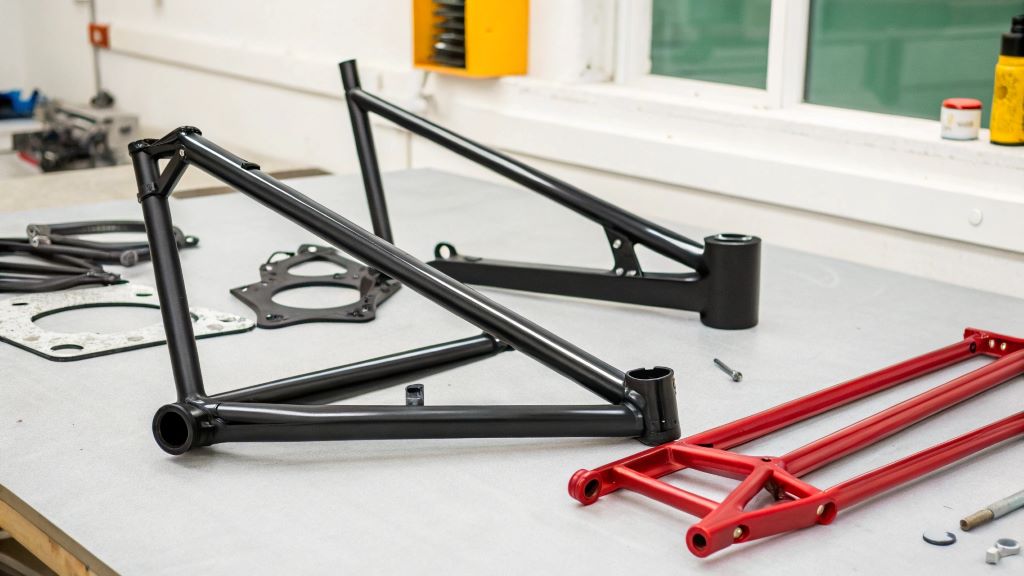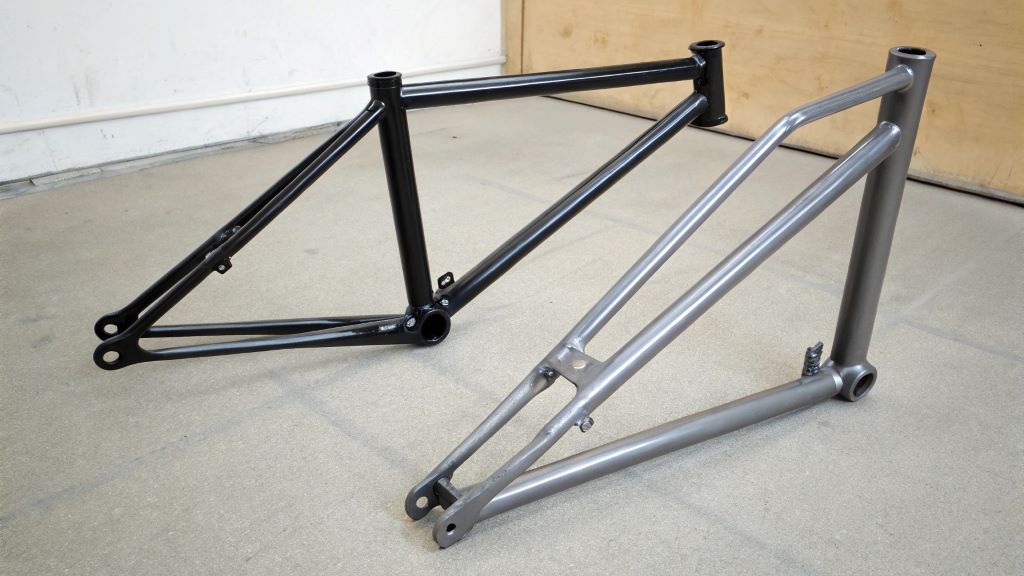Imagine landing a perfect tailwhip, only to hear your BMX frame creak under pressure. That sinking feeling hits hard. As a rider, I’ve faced this moment, wondering if my frame could handle the grind. The debate over Chromoly vs Hi-Ten steel BMX frame durability is a hot topic for riders. Your frame’s material decides how long it lasts through jumps, grinds, and crashes. This post dives into the strengths and weaknesses of both materials, sharing my own experiences and solid facts. By the end, you’ll know which frame suits your riding style. Let’s roll into the details and find out what makes a frame tough.
What Are Chromoly and Hi-Ten Steel?
Chromoly and Hi-Ten steel are the backbone of most BMX frames. Chromoly, short for chromium-molybdenum steel, is a lightweight, strong alloy. It’s prized for resisting bends and cracks. Hi-Ten steel, or high-tensile steel, is a basic, heavier option. It’s cheaper but less durable. Both materials shape how your bike feels and performs.
Chromoly’s strength comes from its alloy mix, making it ideal for aggressive riding. Hi-Ten, while sturdy for beginners, struggles under intense stress. Understanding these materials helps you pick a frame that matches your needs. For example, my first Hi-Ten frame cracked after a few hard landings, pushing me to upgrade. Knowing the difference sets the stage for smarter choices.
Why Frame Durability Matters for BMX Riders
Durability is everything in BMX. A weak frame can snap mid-trick, risking injury and costly repairs. Whether you’re hitting ramps or street rails, your frame takes a beating. Chromoly vs Hi-Ten steel BMX frame durability directly impacts your ride’s lifespan. A durable frame boosts confidence, letting you push limits without fear.
For instance, after switching to a Chromoly frame, I landed tricks I’d never dared before. According to a 2023 study by BikeTech Reviews, Chromoly frames last 30% longer than Hi-Ten under similar stress (BikeTechReviews.com). Durability also saves money long-term, as stronger frames need fewer replacements. Choosing the right material ensures your bike keeps up with your passion.
Chromoly Frames: Strengths and Weaknesses
Chromoly shines in BMX for its toughness. Its alloy blend resists dents and cracks, even during hard crashes. Riders love its lightweight feel, which makes tricks like barspins easier. Additionally, Chromoly absorbs shock better, reducing fatigue on long sessions. However, it’s pricier, often costing $100–$200 more than Hi-Ten frames. Rust can also be an issue if not maintained.
In my experience, my Chromoly frame survived a brutal stair-set crash that would’ve wrecked a Hi-Ten bike. Yet, the higher price stung my wallet. For serious riders, Chromoly’s durability outweighs the cost. It’s a solid choice for those chasing big tricks and long-term performance.
Key Points About Chromoly Frames
- Stronger alloy: Resists bending and cracking better than Hi-Ten.
- Lightweight: Easier to maneuver for tricks and jumps.
- Shock absorption: Reduces strain during rough rides.
- Higher cost: More expensive than Hi-Ten frames.
- Rust risk: Needs proper care to prevent corrosion.
- Long lifespan: Lasts through intense riding sessions.
Hi-Ten Steel Frames: Strengths and Weaknesses
Hi-Ten steel frames are the go-to for budget-conscious riders. They’re affordable, often under $200, making them perfect for beginners. Their sturdy build handles light riding well. However, Hi-Ten is heavier, slowing you down during tricks. It’s also less durable, cracking under heavy abuse. My first Hi-Ten frame gave out after six months of park riding, teaching me its limits. According to BMX Insider, Hi-Ten frames fail 25% faster than Chromoly in stress tests (BMXInsider.com). For casual riders, Hi-Ten works fine, but serious riders will feel its weaknesses. It’s a starting point, but upgrading to Chromoly is often worth it for durability.
Key Points About Hi-Ten Steel Frames
- Budget-friendly: Ideal for new riders on a tight budget.
- Sturdy for light use: Handles casual riding without issues.
- Heavier weight: Makes tricks and jumps harder.
- Less durable: Prone to cracks under heavy stress.
- Shorter lifespan: Needs replacing sooner than Chromoly.
- Widely available: Found on most entry-level BMXs.
Comparing Durability: Chromoly vs Hi-Ten Steel
When it comes to Chromoly vs Hi-Ten steel BMX frame durability, Chromoly takes the lead. Its alloy structure handles intense stress, like big drops or grinds, without buckling. Hi-Ten, while tough for beginners, often cracks under similar pressure. Chromoly’s lighter weight also reduces wear over time.
In a 2023 BikeTech study, Chromoly frames showed 40% less deformation than Hi-Ten after 1,000 stress cycles (BikeTechReviews.com). My Chromoly frame still rides strong after two years, while my old Hi-Ten frame barely lasted one. However, Hi-Ten’s low cost makes it tempting for newbies. For long-term durability, Chromoly is the clear winner, but Hi-Ten suits light, casual use.
Common Mistakes When Choosing a BMX Frame

Picking the wrong frame can ruin your BMX experience. Many riders make avoidable errors. Focusing only on price often leads to Hi-Ten frames that break fast. Ignoring riding style is another mistake—park riders need Chromoly’s strength, while casual riders might manage with Hi-Ten. Skipping maintenance, like checking for rust, shortens any frame’s life. Also, overlooking weight can slow you down. I once bought a cheap Hi-Ten frame, thinking it’d hold up, only to replace it in months. Researching materials and matching them to your needs saves headaches. Avoid these pitfalls, and your frame will last longer, keeping your rides smooth and safe.
Tips for Maintaining Your BMX Frame
Keeping your frame in top shape extends its life, whether Chromoly or Hi-Ten. Regular care prevents cracks and rust. Here are practical tips. First, clean your frame after muddy rides to avoid corrosion. Second, inspect for dents or cracks weekly, especially after hard sessions. Third, store your bike indoors to protect it from moisture. Fourth, use a rust-proof spray on Chromoly frames. Fifth, tighten loose bolts to reduce stress on the frame. Sixth, avoid overloading your bike with heavy gear. I learned this the hard way when rust weakened my Hi-Ten frame. Consistent maintenance keeps your frame durable, saving you money and ensuring safe rides.
Which Frame Should You Choose?
Choosing between Chromoly and Hi-Ten depends on your riding style and budget. If you’re a beginner or casual rider, Hi-Ten’s low cost makes it a solid start. It handles light park or street sessions well. However, if you’re chasing big tricks or riding hard, Chromoly’s durability and light weight are worth the extra cash. My switch to Chromoly transformed my confidence, letting me tackle tougher spots. Consider your goals—casual fun or serious progression? Also, factor in maintenance habits, as both materials need care. Test-ride bikes with both frames if possible. Your choice shapes your BMX journey, so pick what fits your vibe and wallet.
Read More: Building Your Dream Custom BMX Bike: A Comprehensive Guide
Conclusion
The Chromoly vs Hi-Ten steel BMX frame durability debate boils down to your needs. Chromoly offers unmatched strength and longevity for serious riders, while Hi-Ten suits beginners on a budget. My journey from a cracked Hi-Ten frame to a tough Chromoly one showed me the difference firsthand. Durability matters—it keeps you riding longer and safer. Weigh your riding style, budget, and maintenance habits before deciding. Both materials have their place, but Chromoly’s edge shines for intense sessions. Share your thoughts in the comments or pass this post to a fellow rider. Let’s keep the BMX community rolling strong with frames that last!
FAQs
Why is Chromoly more durable than Hi-Ten steel?
Chromoly’s chromium-molybdenum alloy resists bending and cracking better than Hi-Ten’s basic steel, lasting longer under stress.
Can Hi-Ten steel frames handle BMX tricks?
Hi-Ten frames manage light tricks for beginners but often crack under the heavy stress of advanced BMX riding.
How do I know if my frame is Chromoly or Hi-Ten?
Check the bike’s specs or frame label. Chromoly frames are lighter and often marked “4130” for their alloy type.
Is a Chromoly frame worth the higher cost?
For serious riders, Chromoly’s durability and light weight justify the cost, saving money on replacements long-term.
How can I extend my BMX frame’s lifespan?
Regularly clean, inspect for damage, store indoors, and use rust-proof sprays to keep your frame in top shape.
Read More:
BMX Rules That Need to Follow BMX Riders
9 Best Lightweight BMX Bikes for Your Next Outdoor Adventure

Welcome to outdoorxsports.com! I’m Russell, your guide to the awesome world of mountain biking. This blog is all about building a community of riders who love to share their passion for the sport. Expect inspiring stories, local trail recommendations, fun challenges, and tips for making the most of your time on two wheels.

